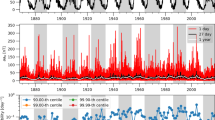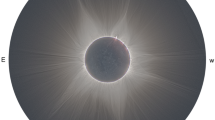Abstract
By using two tri-axial ellipsoids to approximate the two asteroids, forced orbits around triangular libration points of the binary asteroid system (BAS) induced by solar radiation pressure are studied. The work is firstly carried out in the doubly synchronous binary asteroid system (DSBAS). The results show that the amplitude of the forced periodic orbit can be large, even for small to moderate surface area-to-mass ratios of the spacecraft. The position, amplitude, and stability of these forced periodic orbits are influenced by the asteroids' non-spherical terms. Also, the stability of them may be different, depending on the Sun's motion direction w.r.t. to the BAS's orbit motion direction. This study is then generalized to the asynchronous and synchronous BAS (ABAS and SBAS, respectively). The forced orbits in the complete system are quasi-periodic orbits around the forced periodic orbit of the averaged system.
Similar content being viewed by others
Change history
11 February 2022
A Correction to this paper has been published: https://doi.org/10.1007/s42064-022-0136-2
References
Margot, J. L., Nolan, M. C., Benner, L. A. M., Ostro, S. J., Jurgens, R. F., Giorgini, J. D., Slade, M. A., Campbell, D. B. Binary asteroids in the near-earth object population. Science, 2002, 296(5572): 1445–1448.
Pravec, P., Scheirich, P., Kušnirák, P., Hornoch, K., Galád, A., Naidu, S. P., Pray, D. P., Világi, J., Gajdoš, Š., Kornoš, L. et al. Binary asteroid population. 3. Secondary rotations and elongations. Icarus, 2016, 267: 267–295.
Bottke, W. F. Jr., Vokrouhlický, D., Rubincam, D. P., Nesvorný, D. The Yarkovsky and Yorp effects: Implications for asteroid dynamics. Annual Review of Earth and Planetary Sciences, 2006, 34(1): 157–191.
Walsh, K. J., Richardson, D. C., Michel, P. Spin-up of rubble-pile asteroids: Disruption, satellite formation, and equilibrium shapes. Icarus, 2012, 220(2): 514–529.
Sánchez, P., Scheeres, D. J. The strength of regolith and rubble pile asteroids. Meteoritics & Planetary Science, 2014, 49(5): 788–811.
Yu, Y., Richardson, D. C., Michel, P. Structural analysis of rubble-pile asteroids applied to collisional evolution. Astrodynamics, 2017, 1(1): 57–69.
Scheeres, D. J. Stability of the planar full 2-body problem. Celestial Mechanics and Dynamical Astronomy, 2009, 104(1–2): 103–128.
Jacobson, S. A., Scheeres, D. J. Dynamics of rotationally fissioned asteroids: Source of observed small asteroid systems. Icarus, 2011, 214(1): 161–178.
Ćuk, M., Burns, J. Effects of thermal radiation on the dynamics of binary NEAs. Icarus, 2005, 176(2): 418–431.
McMahon, J., Scheeres, D. Secular orbit variation due to solar radiation effects: A detailed model for BYORP Celestial Mechanics and Dynamical Astronomy, 2010, 106(3): 261–300.
Yu, Y., Michel, P., Schwartz, S. R., Naidu, S. P., Benner, L. A. M. Ejecta cloud from the AIDA space project kinetic impact on the secondary of a binary asteroid: I. mechanical environment and dynamical model. Icarus, 2017, 282: 313–325.
Hirabayashi, M., Davis, A. B., Fahnestock, E. G., Richardson, D. C., Michel, P., Cheng, A. F., Rivkin, A. S., Scheeres, D. J., Chesley, S. R., Yu, Y. et al. Assessing possible mutual orbit period change by shape deformation of Didymos after a kinetic impact in the NASA-led Double Asteroid Redirection Test. Advances in Space Research, 2019, 63(8): 2515–2534.
Grundy, W. M., Noll, K. S., Buie, M. W., Levison, H. F. The upcoming mutual event season for the Patroclus-Menoetius Trojan binary. Icarus, 2018, 305: 198–202.
Hou, X. Y., Scheeres, D. J., Xin, X. S. Mutual potential between two rigid bodies with arbitrary shapes and mass distributions. Celestial Mechanics and Dynamical Astronomy, 2017, 127(3): 369–395.
Hou, X. Y. Integration of the full two-body problem by using generalized inertia integrals. Astrophysics and Space Science, 2018, 363: 38.
Boué, G. The two rigid body interaction using angular momentum theory formulae. Celestial Mechanics and Dynamical Astronomy, 2017, 128(2-3): 261–273.
Shi, Y., Wang, Y., Xu, S. J. Mutual gravitational potential, force, and torque of a homogeneous polyhedron and an extended body: An application to binary asteroids. Celestial Mechanics and Dynamical Astronomy, 2017, 129(3): 307–320.
Jiang, Y., Zhang, Y., Baoyin, H. X., Li, J. F. Dynamical configurations of celestial systems comprised of multiple irregular bodies. Astrophysics and Space Science, 2016, 361: 306.
Dirkx, D., Mooij, E., Root, B. Propagation and estimation of the dynamical behaviour of gravitationally interacting rigid bodies. Astrophysics and Space Science, 2019, 364(2): 37.
Lei, H. L., Circi, C., Ortore, E., Condoleo, E., Xu, B. Quasi-frozen orbits around a slowly rotating asteroid. Journal of Guidance, Control, and Dynamics, 2019, 42(4): 794–809.
Sharma, R. K., Taqvi, Z. A., Bhatnagar, K. B. Existence and stability of libration points in the restricted three-body problem when the primaries are triaxial rigid bodies. Celestial Mechanics and Dynamical Astronomy, 2001, 79(2): 119–133.
Li, X. Y., Qiao, D., Barucci, M. A. Analysis of equilibria in the doubly synchronous binary asteroid systems concerned with non-spherical shape. Astrodynamics, 2018, 2(2): 133–146.
Mittal, A., Ahmad, I., Bhatnagar, K. B. Periodic orbits generated by Lagrangian solutions of the restricted three body problem when one of the primaries is an oblate body. Astrophysics and Space Science, 2009, 319(1): 63–73.
Shang, H. B., Wu, X. Y., Cui, P. Y. Periodic orbits in the doubly synchronous binary asteroid systems and their applications in space missions. Astrophysics and Space Science, 2015, 355(1): 69–87.
Shi, Y., Wang, Y., Xu, S. J. Global search for periodic orbits in the irregular gravity field of a binary asteroid system. Acta Astronautica, 2018, https://doi.org/10.1016/j.actaastro.2018.10.014.
Chappaz, L., Howell, K. C. Exploration of bounded motion near binary systems comprised of small irregular bodies. Celestial Mechanics and Dynamical Astronomy, 2015, 123(2): 123–149.
Xin, X. S., Hou, X. Y. Equilibrium points in the restricted full three-body problem with ellipsoidal primaries. The Astronomical Journal, 2017, 154: 37.
Hou, X. Y., Xin, X. S., Feng, J. L. Genealogy and stability of periodic orbit families around uniformly rotating asteroids. Communications in Nonlinear-Science and Numerical Simulation, 2018, 56: 93–114.
Díez, C., Jorba, À., Simó, C. A dynamical equivalent to the equilateral libration points of the earth-moon system. Celestial Mechanics and Dynamical Astronomy, 1991, 50(1): 13–29.
Hou, X. Y., Liu, L. On quasi-periodic motions around the triangular libration points of the real Earth-Moon system. Celestial Mechanics and Dynamical Astronomy, 2010, 108(3): 301–313.
Hou, X. Y., Liu, L. On quasi-periodic motions around the collinear libration points in the real Earth-Moon system. Celestial Mechanics and Dynamical Astronomy, 2011, 110: 71–98.
Zeng, X. Y., Gong, S. P., Li, J. F., Alfriend, K. T. Solar sail body-fixed hovering over elongated asteroids. Journal of Guidance, Control, and Dynamics, 2016, 39(6): 1223–1231.
Xin, X. S., Scheeres, D. J., Hou, X. Y. Forced periodic motions by solar radiation pressure around uniformly rotating asteroids. Celestial Mechanics and Dynamical Astronomy, 2016, 126(4): 405–432.
Scheeres, D. Satellite dynamics about small bodies: Averaged solar radiation pressure effectsl. Journal of the Astronautical Sciences, 1999, 47(1): 25–46.
Broschart, S. B., Lantoine, G., Grebow, D. J. Quasiterminator orbits near primitive bodies. Celestial Mechanics and Dynamical Astronomy, 2014, 120(2): 195–215.
Feng, J., Hou, X. Y. Secular dynamics around small bodies with solar radiation pressure. Communications in Nonlinear Science and Numerical Simulation, 2019, 76: 71–91.
Damme, F., Hussmann, H., Oberst, J. Spacecraft orbit lifetime within two binary near-Earth asteroid systems. Planetary and Space Science, 2017, 146: 1–9.
Batygin, K., Morbidelli, A. Spin-spin coupling in the solar system. The Astro-physical Journal, 2015, 810: 110.
Nadoushan, M. J., Assadian, N. Geography of the rotational resonances and their stability in the ellipsoidal full two body problem. Icarus, 2016, 265: 175–186.
Hou, X. Y., Xin, X. S. A note on the spin-orbit, spin-spin, and spin-orbit-spin resonances in the binary minor planet system. The Astronomical Journal, 2017, 154: 257.
Burns, J. A., Lamy, P. L., Soter, S. Radiation forces on small particles in the solar system. Icarus, 1979, 40(1): 1–48.
Hou, X. Y., Xin, X. S. A note on the full two-body problem and related restricted full three-body problem. Astrodynamics, 2018, 2(1): 39–52.
Hou, X. Y., Xin, X. S, Tang, J. S., Liu, L. Dynamics around libration points in the binary asteroid system. In: Proceedings of the 25th International Symposium on Space Flight Dynamics, 2015.
Lei, H. L., Xu, B. High-order analytical solutions around triangular libration points in the circular restricted three-body problem. Monthly Notices of the Royal Astronomical Society, 2013, 434(2): 1376–1386.
Qian, Y. J., Yang, L. Y., Yang, X. D., Zhang, W. Parametric stability analysis for planar bicircular restricted four-body problem. Astrodynamics, 2018, 2(2): 147–159.
Bellerose, J., Scheeres, D. J. Stability of equilibrium points in the restricted full three-body problem. Acta Astronautica, 2007, 60(3): 141–152.
Scheeres, D. J. Orbital Motion in Strongly Perturbed Environments: Applications to Asteroid, Comet and Planetary Satellite Orbiters. New York: Springer, 2012.
Mignard, F., Henon, M. About an unsuspected integrable problem. Celestial Mechanics, 1984, 33(3): 239–250.
Hamilton, D. P., Burns, J. A. Orbital stability zones about asteroids II. The destabilizing effects of eccentric orbits and of solar radiation. Icarus, 1992, 96(1): 43–64.
Szalay, J. R., Horányi, M. The impact ejecta environment of near earth asteroids. The Astrophysical Journal Letters, 2016, 830: L29.
Liu, X. D., Schmidt, J. Dust arcs in the region of Jupiter's Trojan asteroids. Astronomy & Astrophysics, 2018, 609: A57.
Liu, X. D., Schmidt, J. Dust in the Jupiter system outside the rings. Astrodynamics, 2019, 3(1): 17–29.
Cermák, I., Grün, E., Švestka, J. New results in studies of electric charging of dust particles. Advances in Space Research, 1995, 15(10): 59–64.
Tribeche, M., Shukla, P. K., Charging of a dust particle in a plasma with a non extensive electron distribution function. Physics of Plasmas, 2011, 18: 103702.
Acknowledgements
This work was supported by National Natural Science Foundation of China (Grant Nos. 11773017, 11673072).
Author information
Authors and Affiliations
Corresponding author
Additional information
Xi-Yun Hou received his Ph.D. degree in astronomy from Nanjing University, China, in 2008. Now he is a professor at the School of Astronomy and Space Science of Nanjing University. His research interests focus on topics related with celestial mechanics and astrodynamics. Currently, he is doing research related to asteroids, and libration points of the real Earth-Moon system.
Xiao-Sheng Xin received his Ph.D. degree in astronomy from Nanjing University, China, in 2017. He is currently a research assistant at Beijing Institute of Tracking and Telecommunications Technology. His research interests focus on astrodynamics such as orbital dynamics of spacecraft or natural bodies around asteroids, and statistical orbit determination such as the orbit determination around Earth-Moon collinear libration point.
Jing-Lang Feng received her Ph.D. degree in aerospace engineering from Delft University of Technology, the Netherlands, in 2016. She performed systematic study about orbital dynamics in the vicinity of contact binary asteroids, in terms of stability, frozen and periodic orbits, and resonances. Currently she is a postdoc at the Faculty of Astronomy and Space Sciences, Nanjing University, China. She studies the effects of solar radiation pressure on the long term evolution of orbital motion around asteroids, and uncertainty propagation and analysis in small body missions.
Rights and permissions
About this article
Cite this article
Hou, XY., Xin, XS. & Feng, JL. Forced motions around triangular libration points by solar radiation pressure in a binary asteroid system. Astrodyn 4, 17–30 (2020). https://doi.org/10.1007/s42064-019-0060-2
Received:
Accepted:
Published:
Issue Date:
DOI: https://doi.org/10.1007/s42064-019-0060-2




